|
This species has been introduced into California. It is not a native species.
|
It is unlawful to import, transport, or possess any Watersnakes of the genus Nerodia in
California except under permit issued by the California Department of Fish and Wildlife.
(California Code of Regulations, Title 14, Excerpts, Section 671)
The California Watersnakes Site reports on news, publications,
and
sightings related to non-native watersnake species (Nerodia) in California.
If you see a watersnake in the wild in California at a location not mentioned on the
California Watersnakes Site, please report it to California Nerodia Watch at iNaturalist.
(Don't confuse Watersnakes (Nerodia) with native California gartersnakes. Most gartersnakes
have stripes on the sides and sometimes on the back. Watersnakes have no stripes.)
|
The following pictures of Watersnakes found in California are of the subspecies of Southern Watersnake
known as
Florida Watersnake - Nerodia fasciata pictiventris (Cope, 1895)
|
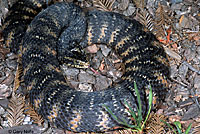 |
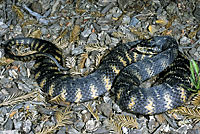 |
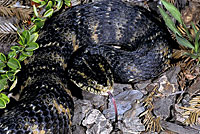 |
| Adult, Sacramento County. © Gary Nafis. Specimen courtesy of Eric Stitt |
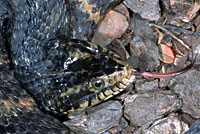 |
 |
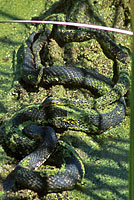 |
| Adult, Sacramento County |
Adult, Sacramento County |
Two adults breeding on top of
a log in a pond in Sacramento County
|
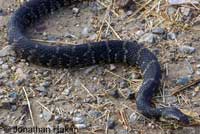 |
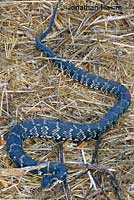 |
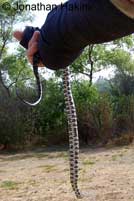 |
| Adult, Los Angeles County © Jonathan Hakim |
 |
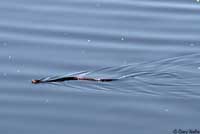 |
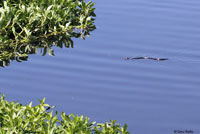 |
| |
Adult, Los Angeles County |
|
 |
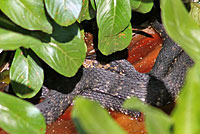 |
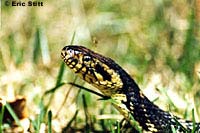 |
| Adult, Los Angeles County |
Adult, Sacramento County,
© Eric Stitt |
| |
| Unknown Species of Watersnake found in California |
| |
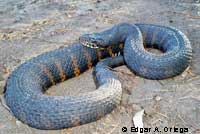 |
|
| Adult, San Joaquin County. © Edgar Ortega |
The species of this Nerodia is unclear. It is included here until I find out exactly what it is.
Environmentalists fear that the Nerodia introduced into Folsom and Roseville may eventually find their way into the Central Valley where they could out-compete the already endangered Giant Gartersnakes. This one was found in an irrigation canal near Manteca in May, 2011. It could indicate that these snakes have already spread into Valley waters, or it could be a single snake released in that area or even a new population of alien Nerodia. |
| |
|
|
| Nerodia fasciata pictiventris from the Lower Colorado River area of Arizona |
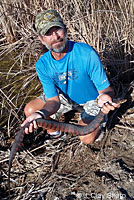 |
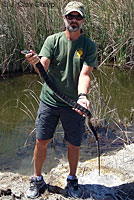 |
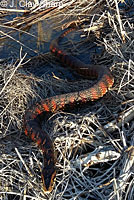 |
| Adult snakes from Mittry Lake, Arizona © J. Clay Sharp |
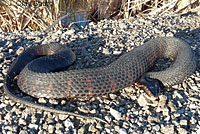 |
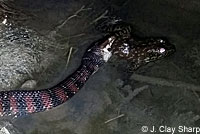 |
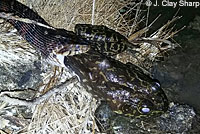 |
| Adult snakes from Mittry Lake, Arizona, including one eating an introduced American Bullfrog © J. Clay Sharp |
| |
| Habitat |
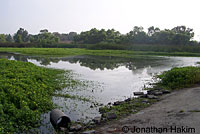 |
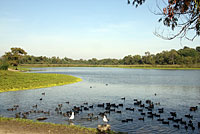 |
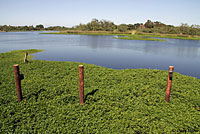 |
Habitat, Los Angeles County
© Jonathan Hakim |
Habitat, Los Angeles County
|
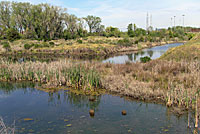 |
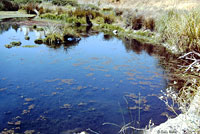 |
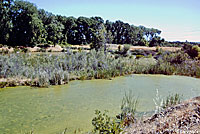 |
| Habitat, Sacramento County |
Habitat, Sacramento County |
Habitat, Sacramento County |
More pictures of Florida Watersnakes in Florida
|
|
Description |
Not Dangerous - This snake does not have venom that can cause death or serious illness or injury in most humans.
Commonly described as "harmless" or "not poisonous" to indicate that its bite is not dangerous, but "not venomous" is more accurate. (A poisonous snake can hurt you if you eat it. A venomous snake can hurt you if it bites you.)
The saliva of this species contains a mild anticoagulant which can cause inflammation and more than usual bleeding, but this poses little risk to humans.
|
| Size |
Adults are generally 22 - 40 inches long (56 - 101 cm) and up to 60 inches (152 cm.)
|
| Appearance |
A dark, heavy-bodied snake with heavily-keeled scales.
The head has a more acute downward angle than Nerodia sipedon. |
| Color and Pattern |
Color is yellowish to reddish-gray with 40 or more dark cross-bands on the entire length of the body.
Old snakes may be almost entirely solid dark brown.
There is a dark stripe extending from the eye to the corner of the mouth.
Dark spots mark the venter, typically dark square or triangular spots sometimes with wavy cross lines. |
| Young |
Juveniles are paler with a stronger pattern than adults.
|
| Life History and Behavior |
Activity |
Active during the day, and also at night.
Basks in the sun at water's edge on logs or overhanging limbs, moving into dens along banks in cold weather.
Will leave the water and travel overland a mile or more in search of food. |
| Defense |
| If threatened, may emit a strong-smelling musk and feces from its cloaca, flatten its body and strike repeatedly. |
| Diet and Feeding |
| Eats fish, frogs, salamanders, crayfish. |
| Reproduction |
Females are ovoviviparous - they carry the eggs internally until the young are born live.
|
| Habitat |
Occurs in and around permanent bodies of water, especially those bordered by woods.
|
| Geographical Range |
The species occurs naturally in the southeastern United States, from North Carolina to Florida, up the Mississippi into southern Illinois and east into central Texas.
Introduced Established Populations in California
The Southern Watersnake has been established in at least three locations in California.
1 - Established
in and around Lake Natoma in the city of Folsom, Sacramento County
(Peter S. Balfour, Eric W. Stitt, Michael M. Fuller and Tara K. Luckau. Herpetological Review 38(4), 2007),
2 - Established at Machado Lake (aka Harbor Park Lake) in Harbor City, Los Angeles County.
Identified as Nerodia fasciata pictiventris - Florida Watersnake.
(Michael M. Fuller and Bryce W. Trevett. Herpetological Review 37(3), 2006)
Biologists from the USGS and CDFW with authorization from the LA Dept. of Parks and Recreation have made efforts to eradicate Nerodia from the lake. In 2010 approximately 300 Florida watersnakes were trapped and removed. Necropsies on the snakes performed by biologists with the USGS, the US Fish and Wildlife Service, and UC Davis, found no remains of native species in their digestive tracts. Instead, the watersnakes were found to prey mostly on other invasive species found in the lake. According to USGS snake ecologist Robert Reed, young snakes prey mostly on nonnative mosquito fish, while older snakes prey on bullfrogs, and bullfrog tadpoles. The ongoing effort to clean up the lake and improve the water quality will increase the food source for the snakes and won't reduce their number. Reed says that the lake would have to be drained for at least a year in order to get rid of the source of food for the watersnakes, which would be the only sure way to get rid of the snakes.
LA Times 6/11/16
3 - In October 2015 state biologists confirmed the presence of southern water snake (Nerodia fasciata) northeast of Yuma Arizona along the Colorado River at the border of California and Arizona at Laguna Dam, Senator's Wash, and at Mittry Lake in Arizona.
(J. Clayton Sharp, Herpetological Review 49(3), June, 2018.)
A U.S.F.W.S. article, Battling the Invasion of Watersnakes, mentions the possibility that equipment traveling from a military base in the southeastern U.S. to a U.S. Army base near where the snakes have been found could be the source of the watersnake introduction, but Clay Sharp, who discovered the Nerodia in the Yuma Basin, told me that he has never seen any Army vehicles or equipment in the area where he has captured the snakes but he did see a Dredge from Florida and working tanker trucks from Louisiana doing restoration work in the Multi-Species Conservation Project area and he thinks that could be the source of the introduction. While snakes have been known to hitch a ride on military planes and vehicles (the Brown Tree Snake was accidentally transported to Guam either in ship cargo or by being transported on aircraft, probably hidden in the landing gear) I think it's most likely that somebody simply dumped some unwanted pet snakes in the area.
|
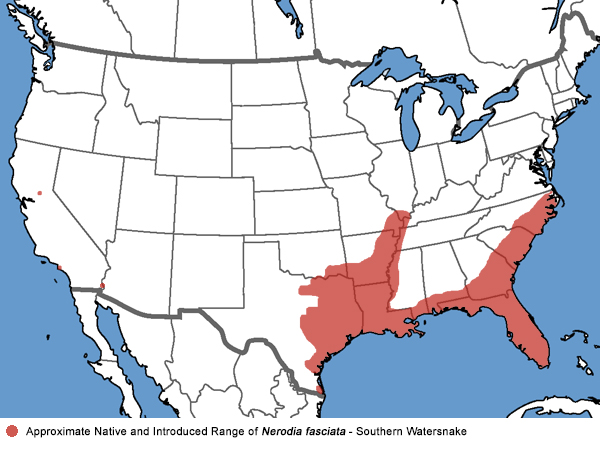 |
| Notes on Taxonomy |
Watersnakes in Harbor City have been identified as Nerodia fasciata pictiventris - Florida Watersnake.
(Michael M. Fuller and Bryce W. Trevett. Herpetological Review 37(3), 2006).
---------------------------------------------------------------------------------------------------------------------------------------------------------------------
Using genetic analysis, watersnakes in the Folsom area have also been identified by as Nerodia fasciata pictiventris - Florida Watersnake. (Peter S. Balfour, Eric W. Stitt, Michael M. Fuller and Tara K. Luckau. Herpetological Review 38(4), 2007)
---------------------------------------------------------------------------------------------------------------------------------------------------------------------
According to Michael Fuller of the Nerodia Working Group, a reproducing population of N. fasciata has existed in Harbor City for several years. While the snakes key out to N. f. pictiventris morphologially, preliminary mDNA results (as of 9/08) suggest that they are Nerodia clarkii, or possibly hybrids of N. clarkii and N. f. pictiventris. The habitat is a freshwater lake, typical of that used by N. fasciata, while N. clarkii typically inhabit brackish waters.
---------------------------------------------------------------------------------------------------------------------------------------------------------------------
"Rautsaw et al. (2021, Molecular Biology and Evolution 38: 745–760) examined lineage structure between Florida populations/subspecies. While showing that N. f. fasciatus and N. f. pictiventris can be detected using genomic data, the authors also demonstrated significant gene flow among these lineages. The authors suggest that these subspecies may result from isolation by distance, thus questioning if they should continue to be recognized."
(Nicholson, K. E. (ed.). 2025 SSAR Scientific and Standard English Names List)
---------------------------------------------------------------------------------------------------------------------------------------------------------------------
Alternate and Previous Names (Synonyms)
Nerodia fasciata pictiventris - Florida Water Snake (Conant & Collins 1998, Powell, Conant & Collins 2016)
Cope's water snake (Ditmars 1936)
Florida banded water snake (Conant 1930)
Spotted belly water snake (Safford 1919)
Natrix sipedon pictiventris - Florida Water Snake (Cope 1895)
Natrix sipedon fasciata - Banded water snake (Goode 1873)
Southern water snake (Hurter 1897)
Banded snake
Black water snake
Blue snake
Brown snake
Common water snake
Fasciated (water) snake
Moccasin
Red-bellied water snake
Southern banded water snake
Wampum snake
Water adder
Water moccasin
Water viper
|
| Conservation Issues (Conservation Status) |
Spread of this snake downstream into the Sacramento Valley could possibly threaten populations of the already endangered Giant Gartersnake, Thamnophis gigas. It could also pose a threat to other native fish and wildlife.
As of Janurary 2008 it is unlawful to import, transport, or possess any Watersnakes of the genus Nerodia in California except under permit issued by the California Department of Fish and Wildlife.
(California Code of Regulations, Title 14, Excerpts, Section 671)
See: California Department of Fish and Game Restricted Species Regulations
|
|
| Taxonomy |
| Family |
Colubridae |
Colubrids |
Oppel, 1811 |
| Genus |
Nerodia |
American Watersnakes |
Baird and Girard, 1853 |
Species
|
fasciata |
Southern Watersnake |
(Linnaeus, 1766) |
|
Original Description |
Nerodia fasciata - (Linnaeus, 1766) - Syst. Nat., 12th ed., Vol. 1, p. 378
from Original Description Citations for the Reptiles and Amphibians of North America © Ellin Beltz
|
|
Meaning of the Scientific Name |
Nerodia - Greek - nereis = name of a sea nymph
fasciata - Latin = banded - refers to the banded pattern on dorsum
(Subspecies - pictiventris - Latin = painted, embroidered + ventris = of the belly - refers to the pattern and coloration of the belly)
from Scientific and Common Names of the Reptiles and Amphibians of North America - Explained © Ellin Beltz
|
|
Related or Similar California Snakes |
Thamnophis sirtalis fitchi - Valley Gartersnake
Thamnophis gigas - Giant Gartersnake
Nerodia sipedon - Northern Watersnake
|
|
More Information and References |
The California Nerodia Website reports on news, publications, and sightings related to non-native Nerodia species in California.
California Nerodia Watch enlists reports of wild Nerodia found in California.
California Department of Fish and Wildlife
The Southern Watersnake (Nerodia fasciata) in Folsolm California (PDF)
Gibbons, J. Whitfield, Michael E. Dorcas. North American Watersnakes - A Natural History. University of Oklahoma Press. 2004.
Balfour, P. S., and E. W. Stitt. Geographic distribution: Nerodia fasciata fasciata. Herpetological Review 33:150 2002.
Peter S. Balfour, Eric W. Stitt, Michael M. Fuller and Tara K. Luckau. Herpetological Review 38(4), 2007
J. Clayton Sharp, Herpetological Review 49(3), June, 2018
Michael M. Fuller and Bryce W. Trevett. Herpetological Review 37(3), 2006
Robert Powell, Roger Conant, and Joseph T. Collins. Peterson Field Guide to Reptiles and Amphibians of Eastern and Central North America. Fourth Edition. Houghton Mifflin Harcourt, 2016.
Conant, Roger, and Joseph T. Collins. A Field Guide to Reptiles and Amphibians Eastern and Central North America.
Third Edition, Houghton Mifflin Company, 1998.
Bartlett, R.D., & Alan Tennant. Snakes of North America - Eastern and Central Regions. Gulf Publishing Co., 2000.
|
|
|
The following conservation status listings for this animal are taken from the July 2025 State of California Special Animals List and the July 2025 Federally Listed Endangered and Threatened Animals of California list (unless indicated otherwise below.) Both lists are produced by multiple agencies every year, and sometimes more than once per year, so the conservation status listing information found below might not be from the most recent lists, but they don't change a great deal from year to year.. To make sure you are seeing the most recent listings, go to this California Department of Fish and Wildlife web page where you can search for and download both lists:
https://www.wildlife.ca.gov/Data/CNDDB/Plants-and-Animals.
A detailed explanation of the meaning of the status listing symbols can be found at the beginning of the two lists. For quick reference, I have included them on my Special Status Information page.
If no status is listed here, the animal is not included on either list. This most likely indicates that there are no serious conservation concerns for the animal. To find out more about an animal's status you can also go to the NatureServe and IUCN websites to check their rankings.
Check the current California Department of Fish and Wildlife sport fishing regulations to find out if this animal can be legally pursued and handled or collected with possession of a current fishing license. You can also look at the summary of the sport fishing regulations as they apply only to reptiles and amphibians that has been made for this website.
It is against the law to capture, move, possess, collect, or distribute this invasive species in California.
See: California Department of Fish and Game Restricted Species Regulations
|
| Organization |
Status Listing |
Notes |
| NatureServe Global Ranking |
|
|
| NatureServe State Ranking |
|
|
| U.S. Endangered Species Act (ESA) |
None |
|
| California Endangered Species Act (CESA) |
None |
|
| California Department of Fish and Wildlife |
None |
|
| Bureau of Land Management |
None |
|
| USDA Forest Service |
None |
|
| IUCN |
|
|
|
|
 Red: Location of non-native populations in California
Red: Location of non-native populations in California





























